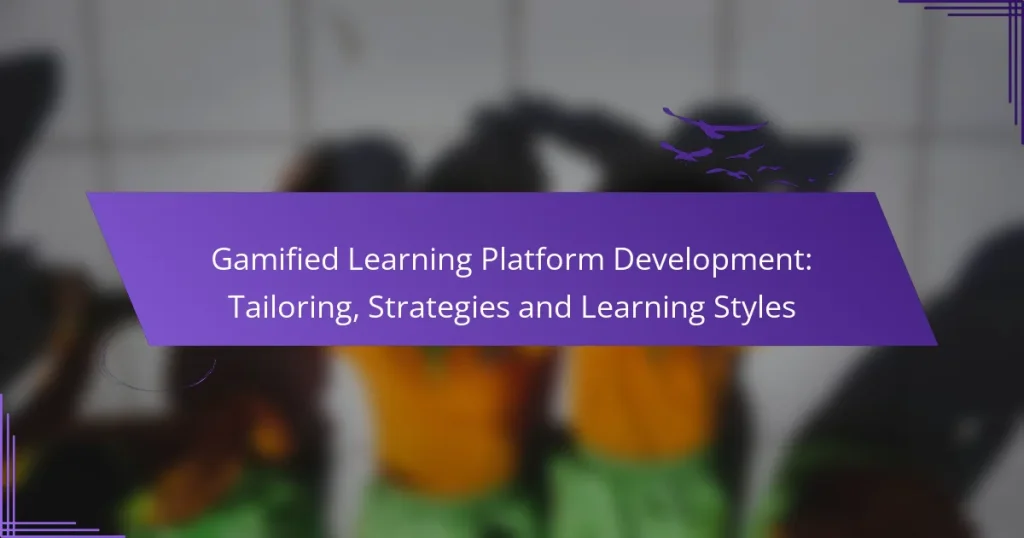Developing a gamified learning platform requires the integration of game mechanics into educational experiences to boost engagement and motivation. By defining clear objectives and employing effective strategies such as adaptive learning and storytelling, educators can create personalized experiences that cater to diverse learning styles, ultimately enhancing retention and collaboration among learners.

How to develop a gamified learning platform?
Developing a gamified learning platform involves integrating game mechanics into educational experiences to enhance engagement and motivation. Key steps include defining objectives, selecting technology, designing user interfaces, implementing gamification elements, and continuously testing and refining the platform based on user feedback.
Define objectives and target audience
Clearly defining the objectives of your gamified learning platform is crucial for its success. Identify what you want to achieve, such as improving knowledge retention or increasing user engagement, and tailor your platform accordingly.
Understanding your target audience is equally important. Consider factors like age, learning preferences, and skill levels to create content that resonates with users and meets their needs.
Choose appropriate technology stack
Selecting the right technology stack is essential for building a robust gamified learning platform. Consider using popular frameworks and languages such as JavaScript, HTML5, and CSS for front-end development, along with back-end options like Node.js or Python.
Additionally, evaluate learning management systems (LMS) that support gamification features, ensuring compatibility with your chosen technologies for seamless integration.
Design engaging user interfaces
An engaging user interface (UI) enhances the user experience and encourages interaction. Focus on creating intuitive navigation, visually appealing graphics, and responsive design to keep users interested.
Incorporate elements like progress bars, achievement badges, and interactive quizzes to make the learning process more enjoyable and rewarding.
Implement gamification elements
Gamification elements such as points, leaderboards, and challenges can significantly boost user motivation. Consider implementing a points system where users earn rewards for completing tasks or achieving milestones.
Leaderboards can foster a sense of competition among users, while challenges and quests can provide structured learning paths that keep users engaged over time.
Test and iterate based on feedback
Regular testing and iteration are vital for refining your gamified learning platform. Gather user feedback through surveys, interviews, or analytics to identify areas for improvement.
Use this feedback to make data-driven adjustments, enhancing features or content based on user preferences and behaviors to ensure the platform remains effective and engaging.

What strategies enhance gamified learning?
Effective strategies for enhancing gamified learning include incorporating adaptive learning techniques, utilizing storytelling, and implementing social learning features. These approaches engage learners by personalizing their experience, making content relatable, and fostering collaboration.
Incorporate adaptive learning techniques
Adaptive learning techniques tailor educational content to meet individual learner needs, adjusting the difficulty and pace based on performance. This personalization helps maintain engagement and ensures that learners are challenged appropriately without feeling overwhelmed.
For example, platforms can use algorithms to analyze user interactions and modify the learning path accordingly. Offering quizzes that adapt in difficulty based on previous answers is a practical implementation of this strategy.
Utilize storytelling and narrative
Storytelling and narrative create immersive experiences that can enhance retention and motivation. By framing learning objectives within a compelling story, learners can connect emotionally with the material, making it more memorable.
Consider using characters, plots, and challenges that resonate with the target audience. For instance, a history lesson could be presented as a quest through time, where learners must solve puzzles related to historical events to progress.
Implement social learning features
Social learning features encourage collaboration and interaction among learners, which can enhance understanding and retention. By incorporating discussion forums, peer feedback, and group challenges, learners can share insights and learn from one another.
Platforms might include leaderboards or badges to foster a sense of community and healthy competition. This not only motivates learners but also helps them feel part of a larger learning journey, enhancing their overall experience.

How to tailor gamified experiences for different learning styles?
To effectively tailor gamified experiences for various learning styles, it’s essential to understand the unique preferences of each learner. By identifying these styles and customizing content delivery, you can enhance engagement and retention in educational settings.
Identify learning style preferences
Start by assessing the learning style preferences of your audience. Common styles include visual, auditory, reading/writing, and kinesthetic. Surveys or quizzes can help gather this information effectively.
Once you have identified the predominant styles, consider segmenting your audience based on these preferences. This allows for more targeted content that resonates with each group, enhancing the overall learning experience.
Customize content delivery methods
Different learning styles require varied content delivery methods. For visual learners, incorporate infographics and videos, while auditory learners may benefit from podcasts or narrated content. Reading/writing learners often prefer text-based materials, and kinesthetic learners thrive with interactive simulations.
Utilizing a mix of these methods can cater to a broader audience. For instance, combining video tutorials with hands-on activities can engage multiple learning styles simultaneously, fostering a more inclusive environment.
Provide varied assessment types
To effectively evaluate learning outcomes, offer diverse assessment types that align with different learning styles. For example, visual learners might excel in projects that require visual presentations, while kinesthetic learners could perform better in practical demonstrations.
Incorporate quizzes, peer assessments, and creative assignments to ensure all learners have the opportunity to showcase their understanding. This variety not only keeps assessments engaging but also provides a comprehensive view of learner progress.

What are the best practices for user engagement?
Effective user engagement in gamified learning platforms hinges on strategies that motivate and retain learners. By implementing targeted practices, developers can enhance the user experience and foster a deeper connection with the content.
Use rewards and achievements
Incorporating rewards and achievements can significantly boost user engagement. These incentives can range from virtual badges to unlocking new levels or content, providing tangible recognition for users’ efforts.
Consider using a tiered reward system where users earn increasingly valuable rewards as they progress. This approach keeps learners motivated and encourages them to reach higher levels of achievement.
Encourage collaboration and competition
Fostering collaboration and healthy competition among users can enhance engagement. Group challenges or team-based tasks promote social interaction, while leaderboards can motivate users to improve their performance.
To balance collaboration and competition, create opportunities for users to work together on projects while also allowing them to compete for individual recognition. This dual approach can cater to different learning styles and preferences.
Regularly update content and challenges
Keeping content fresh and challenges updated is crucial for maintaining user interest. Regular updates can include new topics, interactive elements, or seasonal events that align with current trends or user interests.
Establish a schedule for content refreshes, such as monthly or quarterly updates, to ensure users always have new material to engage with. This practice not only retains existing users but can also attract new learners seeking innovative experiences.

What tools can be used for gamified learning platform development?
Several tools are available for developing gamified learning platforms, each serving different aspects of the process. Selecting the right tool depends on your specific needs, such as course management, interactive content creation, or course design.
Moodle for course management
Moodle is a widely used open-source learning management system (LMS) that supports gamification features. It allows educators to create engaging courses with badges, leaderboards, and activity completion tracking, enhancing student motivation.
When using Moodle, consider integrating plugins that add gamification elements, such as the Level Up! plugin, which enables users to earn points and levels based on their course participation. This can significantly boost engagement and retention rates.
Unity for interactive content
Unity is a powerful game development platform that can be utilized to create immersive and interactive learning experiences. With its robust graphics and physics engine, Unity allows developers to build simulations and games that can enhance the learning process.
To effectively use Unity, focus on creating scenarios that align with learning objectives. For example, a virtual lab simulation can allow students to experiment in a safe environment, reinforcing theoretical concepts through practical application.
Articulate 360 for course design
Articulate 360 is a comprehensive suite of tools designed for e-learning course development, featuring Storyline and Rise. These tools enable the creation of interactive and visually appealing courses that can incorporate gamification elements like quizzes and branching scenarios.
When designing courses with Articulate 360, leverage its templates and pre-built interactions to save time. Ensure that the gamified elements are seamlessly integrated into the learning flow to maintain learner engagement and enhance the educational experience.

What metrics should be tracked for success?
Tracking the right metrics is essential for evaluating the success of a gamified learning platform. Key performance indicators (KPIs) can provide insights into user engagement, learning outcomes, and overall effectiveness.
User Engagement Metrics
User engagement metrics are crucial for understanding how learners interact with the platform. Common indicators include session duration, frequency of logins, and completion rates of gamified activities. For instance, a platform may aim for users to log in at least three times a week and complete 80% of assigned tasks.
Monitoring these metrics helps identify trends in user behavior, allowing for timely adjustments to enhance engagement. Tools like heatmaps can visualize user interactions, highlighting popular features and areas needing improvement.
Learning Outcomes Metrics
Learning outcomes metrics assess the effectiveness of the educational content delivered through gamification. Key indicators include knowledge retention rates, skill acquisition, and assessment scores. For example, tracking pre- and post-assessment scores can reveal the impact of gamified elements on learning.
It’s beneficial to set benchmarks based on industry standards, such as aiming for a 70% retention rate after a training module. Regularly reviewing these metrics ensures that the learning objectives align with user performance.
User Feedback and Satisfaction
User feedback and satisfaction metrics provide qualitative insights into the learner experience. Surveys and feedback forms can gauge user satisfaction with the platform’s features, content, and overall usability. Aim for a minimum response rate of 30% to ensure reliable data.
Incorporating user feedback into the development process can lead to continuous improvements. For instance, if users express difficulty with a specific game mechanic, adjustments can be made to enhance usability and satisfaction.


